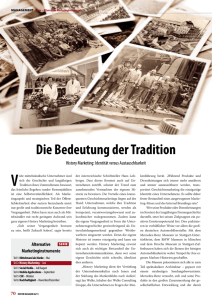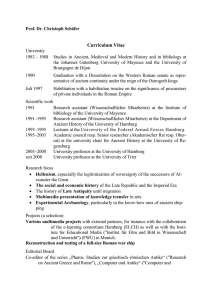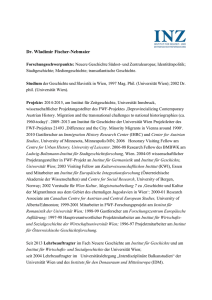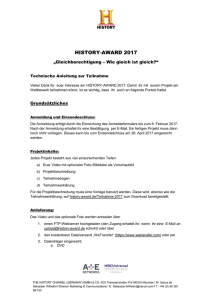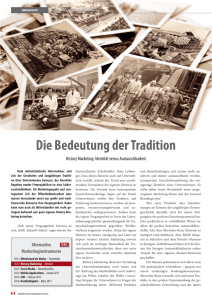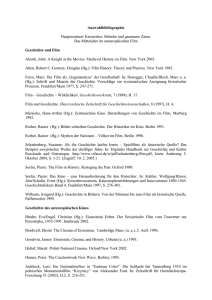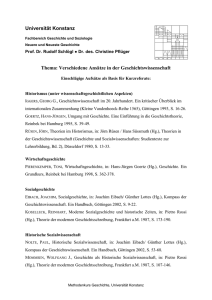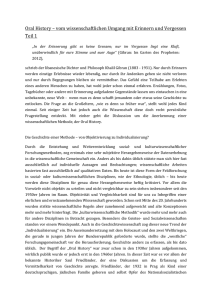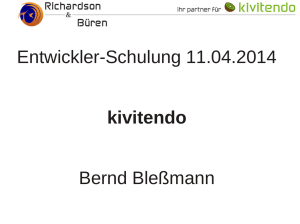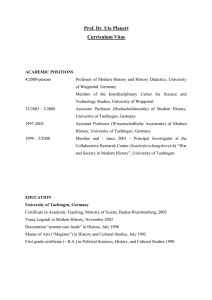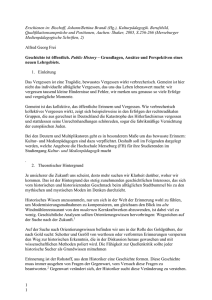Publications Sept. 1 st , 2010
Werbung
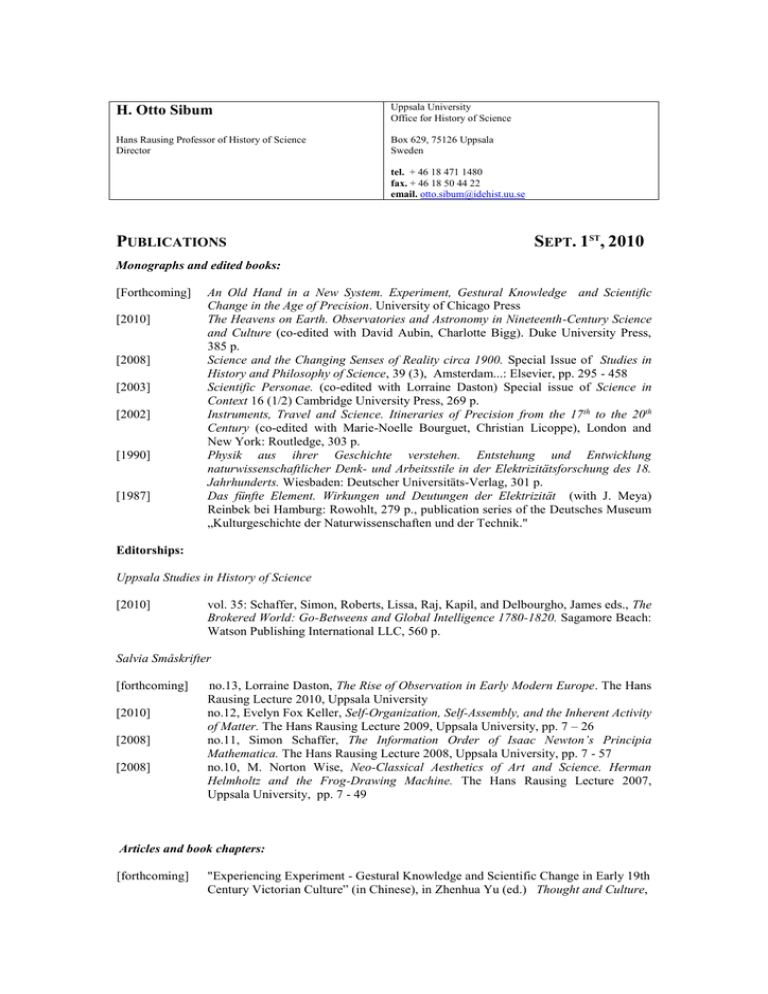
H. Otto Sibum Uppsala University Office for History of Science Hans Rausing Professor of History of Science Director Box 629, 75126 Uppsala Sweden tel. + 46 18 471 1480 fax. + 46 18 50 44 22 email. [email protected] PUBLICATIONS SEPT. 1ST, 2010 Monographs and edited books: [Forthcoming] [2010] [2008] [2003] [2002] [1990] [1987] An Old Hand in a New System. Experiment, Gestural Knowledge and Scientific Change in the Age of Precision. University of Chicago Press The Heavens on Earth. Observatories and Astronomy in Nineteenth-Century Science and Culture (co-edited with David Aubin, Charlotte Bigg). Duke University Press, 385 p. Science and the Changing Senses of Reality circa 1900. Special Issue of Studies in History and Philosophy of Science, 39 (3), Amsterdam...: Elsevier, pp. 295 - 458 Scientific Personae. (co-edited with Lorraine Daston) Special issue of Science in Context 16 (1/2) Cambridge University Press, 269 p. Instruments, Travel and Science. Itineraries of Precision from the 17 th to the 20th Century (co-edited with Marie-Noelle Bourguet, Christian Licoppe), London and New York: Routledge, 303 p. Physik aus ihrer Geschichte verstehen. Entstehung und Entwicklung naturwissenschaftlicher Denk- und Arbeitsstile in der Elektrizitätsforschung des 18. Jahrhunderts. Wiesbaden: Deutscher Universitäts-Verlag, 301 p. Das fünfte Element. Wirkungen und Deutungen der Elektrizität (with J. Meya) Reinbek bei Hamburg: Rowohlt, 279 p., publication series of the Deutsches Museum „Kulturgeschichte der Naturwissenschaften und der Technik." Editorships: Uppsala Studies in History of Science [2010] vol. 35: Schaffer, Simon, Roberts, Lissa, Raj, Kapil, and Delbourgho, James eds., The Brokered World: Go-Betweens and Global Intelligence 1780-1820. Sagamore Beach: Watson Publishing International LLC, 560 p. Salvia Småskrifter [forthcoming] [2010] [2008] [2008] no.13, Lorraine Daston, The Rise of Observation in Early Modern Europe. The Hans Rausing Lecture 2010, Uppsala University no.12, Evelyn Fox Keller, Self-Organization, Self-Assembly, and the Inherent Activity of Matter. The Hans Rausing Lecture 2009, Uppsala University, pp. 7 – 26 no.11, Simon Schaffer, The Information Order of Isaac Newton’s Principia Mathematica. The Hans Rausing Lecture 2008, Uppsala University, pp. 7 - 57 no.10, M. Norton Wise, Neo-Classical Aesthetics of Art and Science. Herman Helmholtz and the Frog-Drawing Machine. The Hans Rausing Lecture 2007, Uppsala University, pp. 7 - 49 Articles and book chapters: [forthcoming] "Experiencing Experiment - Gestural Knowledge and Scientific Change in Early 19th Century Victorian Culture” (in Chinese), in Zhenhua Yu (ed.) Thought and Culture, [2010] [2009] [2008] [2008] [2008] [2006] [2006] [2005] [2004] [2004] [2003] [2003] [2003] [2003] [2002] [2002] [2001] [2001] [2001] [2000] [2000] Si-Mian Institute for Advanced Studies in the Humanities, vol. 10, 2010, pp. The Heavens on Earth – Introduction (with David Aubin, Charlotte Bigg), in The Heavens on Earth. Observatories and Astronomy in Nineteenth-Century Science and Culture (co-edited with David Aubin, Charlotte Bigg). Duke University Press, pp. 132 Historians and the Study of Material Culture – AHR Conversation with L. Auslander, Amy Bentley, H. Leor, H. O. Sibum, C. Witmore. The American Historical Review, vol. 114, no. 5, 1355-1404 “Science and the Changing Senses of Reality circa 1900 - Introduction”, in Studies in History and Philosophy of Science. 39 (3), Amsterdam...: Elsevier, pp. 295-297 “Machines, Bats, and Scholars: Experimental Knowledge in the Late Eighteenth and Nineteenth Centuries” H. Schramm, L. Schwarte, J. Lazardzig (Eds.) Instruments in Art and Science. On the Architectonics of Cultural Boundaries in the 17 th Century. Berlin/New York: W. de Gruyter, pp. 280 - 295 Latente Bilder. Die Techniken wissenschaftlichen Beobachtens in den Werkstätten des Viktorianischen Manchester, in Werner Busch (Hg.) Verfeinertes Sehen. Optik und Farbe im 18. und frühen 19. Jahrhundert. Schriften des Historischen Kollegs, Kolloquien 67. München: Oldenbourg Wissenschaftsverlag, Seite 185-199. Maschinen, Fledermäuse, Schriftgelehrte. Experimentalwissen im späten 18. und 19. Jahrhundert, in H. Schramm, L. Schwarte, J. Lazardzig (Hg.) Instrumente in Wissenschaft und Kunst. Zur Architektonik kultureller Grenzen im 17. Jahrhundert. Geplantes Erscheinen Berlin: De Gruyter Verlag, 302-318. The Number of the Century. A History of a Scientific Fact. In: Wetenschap and Samenleving, Science and Society. Praemium Erasmianum jaarboek 2005. Amsterdam, 61-95 Wissen aus erster Hand. Mikro-Dynamik wissenschaftlichen Wandels im frühviktorianischen England. Historische Anthropologie Dezember 2005, Heft 3: 301-324. What Kind of Science is Experimental Physics? Science, Vol. 306, Issue 5693, S. 6061. Experience – Experiment. The Changing Experiential Basis of Physics, in Research Report 2002 – 2003. Essays. Max-Planck-Institut für Wissenschaftsgeschichte, Berlin, S. 89-97. Experimentalists in the Republic of Letters. Science in Context, 16/1-2, S. 89-120. Introduction: Scientific Personae and Their Histories (mit Lorraine Daston). Science in Context, 16, (1/2) S. 1-8. Joule, James and Robert Mayer, in John L. Heilbron (Hg.) The Oxford Companion to the History of Modern Science, Oxford University Press, New York, S. 428-429. Narrating by Numbers. Keeping an Account of Early 19 th Century Laboratory Experiences, in Frederic Lawrence Holmes, Jürgen Renn, Hans-Jörg Rheinberger (Hg.) Reworking the Bench – Research Notebooks in the History of Science, Kluwer, S. 141-158. Exploring the Margins of Precision, in Marie-Noelle Bourguet, Christian Licoppe und H. Otto Sibum (Hg.) Instruments, Travel and Science. Itineraries of Precision from the 17th to the 20th Century. London, New York: Routledge, S. 216-242. Instruments Travel and Science – Introduction, in Marie-Noelle Bourguet, Christian Licoppe und H. Otto Sibum (Hg.) Instruments, Travel and Science. Itineraries of Precision from the 17th to the 20th Century. London, New York: Routledge, S. 1-19. Il numero d’oro del secolo. Storia di un fatto scientifico. Quaderni storici 108/3, S. 877-903. The Golden Number of the Century. The History of a Scientific Fact. Max-PlanckInstitut für Wissenschaftsgeschichte, Preprint Nr. 174 (Erweiterte englische Version des Aufsatzes in Quaderni Storici). Shifting Scales. Microstudies in Early Victorian Britain. Max-Planck-Institut für Wissenschaftsgeschichte, Preprint 171 (Zur Publikation angenommen in ISIS). Experimentelle Wissenschaftsgeschichte, in Christoph Meinel (Hg.) Instrument – Experiment: Historische Studien. Verlag für Geschichte der Naturwissenschaften und der Technik, S. 61-73. Experimental History of Science, in Svante Lindqvist (Hg.) Museums of Modern Science, Nobel Symposium 112, Science History Publications, S. 77-86. [1998] [1998] [1998] [1998] [1998] [1997] [1995] [1995] [1994] [1993] [1988] Les gestes de la mesure. Joule, les pratiques de la brasserie et la science. Annales. Histoire, Sciences Sociales 53/4-5, S. 745 -774. An Old Hand in a New System, in Jean Paul Gaudellière und Illana Löwy (Hg.) The Invisible Industrialist. Manufactures and the Production of Scientific Knowledge. Basingstoke: Macmillan, S. 23 - 57. Vosproizvedenie eksperimentor po opredeleniju mechaniceskogo ekvivalenta teploty: tocnost' instrumentov i pravil'nost' izmepenij v ranneviktorianskoj Anglii. Voprosy istorii estestvoznanija i techniki 1, S. 9 – 46 (Russische Übersetzung des SHPS Artikels von 1995). Die Sprache der Instrumente. Eine Studie zur Praxis und Repräsentation des Experimentierens, in Michael Heidelberger und Friedrich Steinle (Hg.) Experimental Essays – Versuche zum Experiment. Nomos Verlag, S. 141 - 156. Mechanical Equivalent of Heat Apparatus, in Robert Bud und Deborah Warner (Hg.) Instruments of Science. A Historical Encyclopaedia. New York & London: Garland Publishing, S. 371 - 373. Charles Augustin Coulomb. Einfache Maschinen in Theorie und Praxis, in Karl von Meyenn (Hg.) Die großen Physiker, Volume 1. München: Beck, S. 241-262. Reworking the Mechanical Value of Heat. Instruments of Precision and Gestures of Accuracy in Early Victorian England. Studies in History and Philosophy of Science 26/ 1, S. 73-106. Working Experiments. A history of Gestural Knowledge. The Cambridge Review 116/2325, S. 25-37. Working Experiments. Bodies, Machines and Heat Values, in Richard Staley (Hg.) The Physics of Empire. Whipple Museum of the History of Science, S. 29-56. The Bookkeeper of Nature. Benjamin Franklin's Electrical Research and the Development of Experimental Natural Philosophy in the Eighteenth Century, in J. A. Leo Lemay (Hg.) Reappraising Benjamin Franklin. A Bicentennial Perspective. University of Delaware Press, S. 221-242. Ladung, Ladungserhaltung, Stromkreis, Leitungsstrom – Benjamin Franklins ökonomische Theorie der Elektrizität. Physica didactica 3/4, S. 82-102. Exhibition Catalogues and Popular Writings: [2001] [1995] [1994] [1993] The Friction of Fluids. Making Sense of Experiment. Laboratorium, ed. Hans-Ulrich Obrist and Barbara Vanderlinden, DuMont, pp. 244-249. Enquête sur les mystères d’une expérience. Les Cahiers de Science & Vie 29: 62-80. 1900: The New Age. ( with J. Bennett, R. Brain, S. Schaffer, R. Staley) Whipple Museum of the History of Science, Cambridge. Empires of Physics. A Guide to the Exhibition. (with J. Bennett, R. Brain, K. Bycroft, S. Schaffer, R. Staley) Whipple Museum of the History of Science, Cambridge.
